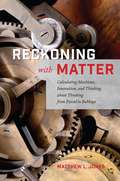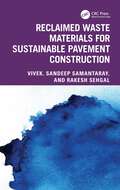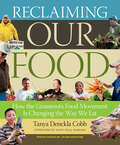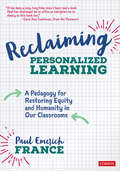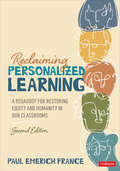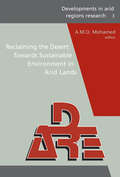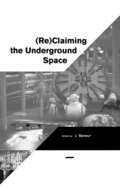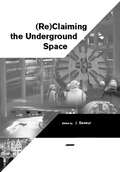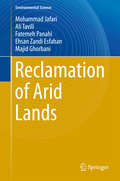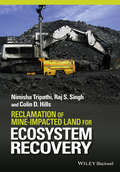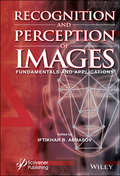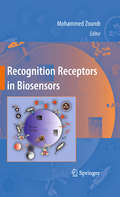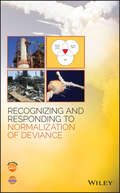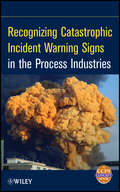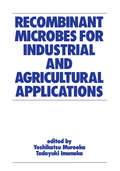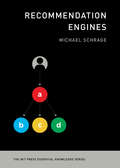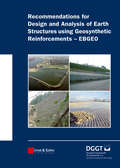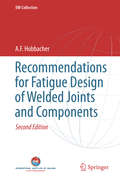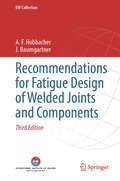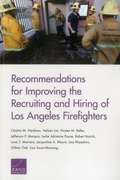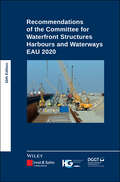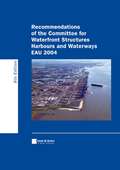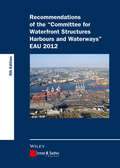- Table View
- List View
Reckoning with Matter: Calculating Machines, Innovation, and Thinking about Thinking from Pascal to Babbage
by Matthew L. JonesFrom Blaise Pascal in the 1600s to Charles Babbage in the first half of the nineteenth century, inventors struggled to create the first calculating machines. All failed—but that does not mean we cannot learn from the trail of ideas, correspondence, machines, and arguments they left behind. In Reckoning with Matter, Matthew L. Jones draws on the remarkably extensive and well-preserved records of the quest to explore the concrete processes involved in imagining, elaborating, testing, and building calculating machines. He explores the writings of philosophers, engineers, and craftspeople, showing how they thought about technical novelty, their distinctive areas of expertise, and ways they could coordinate their efforts. In doing so, Jones argues that the conceptions of creativity and making they exhibited are often more incisive—and more honest—than those that dominate our current legal, political, and aesthetic culture.
Reclaimed Waste Materials for Sustainable Pavement Construction
by null Vivek null Sandeep Samantaray null Rakesh SehgalThis book provides an overview of the use of various waste materials in pavement construction and their potential impact on sustainable infrastructure development. It explores the use of waste materials as alternatives to traditional pavement materials like asphalt and concrete. It discusses the properties and performance of various waste materials and their applications in pavement construction, highlighting the economic and environmental benefits such as reduced greenhouse gas emissions, lower construction costs, and enhanced durability and longevity of pavements.Features: Explores the use of waste materials such as recycled plastics, rubber, glass, and other industrial by-products as alternatives to traditional pavement materials. Provides detailed guidance on the selection, design, and implementation of waste materials. Focuses on the practical application of waste materials in pavement construction. Reviews bio-oils and focuses on plastics from different sources. Includes case studies on waste materials used in pavement structure. This book is aimed at researchers and graduate students in pavement and civil engineering.
Reclaiming Our Food: How the Grassroots Food Movement Is Changing the Way We Eat
by Tanya Denckla CobbReclaiming Our Food tells the stories of people across the United States who are finding new ways to grow, process, and distribute food for their own communities. Discover how abandoned urban lots have been turned into productive organic farms, how a family-run sustainable fish farm can stay local and be profitable, and how engaged communities are bringing fresh produce into school cafeterias. Through photographic essays and interviews with innovative food leaders, you’ll be inspired to get involved and help cultivate your own local food economy.
Reclaiming Personalized Learning: A Pedagogy for Restoring Equity and Humanity in Our Classrooms
by Paul Emerich FranceWhere exactly did personalized learning go so wrong? For teacher and consultant Paul France, at first technology-powered personalized learning seemed like a panacea. But after three years spent at a personalized learning start-up and network of microschools, he soon realized that such corporate-driven individualized learning initiatives do more harm than good, especially among our most vulnerable students. The far-superior alternative? A human-centered pedagogy that prioritizes children over technology. First, let’s be clear: Reclaiming Personalized Learning is not yet-another ed tech book. Instead it’s a user’s guide to restoring equity and humanity to our classrooms and schools through personalization. One part polemical, eleven parts practical, the book describes how to: Shape whole-class instruction, leverage small-group interactions, and nurture a student’s inner-dialogue Cultivate awareness within and among students, and build autonomy and authority Design curriculum with a flexible frame and where exactly the standards fit Humanize assessment and instruction, including the place of responsive teaching Create a sense of belonging, humanize technology integration, and effect socially just teaching and learning—all central issues in equity The truth is this: there’s no one framework, there’s no one tool that makes learning personalized–what personalized learning companies with a vested interest in profits might tempt you to believe. It’s people who personalize learning, and people not technology must be at the center of education. The time is now for all of us teachers to reclaim personalized learning, and this all-important book is our very best resource for getting started. “This is a compelling and critically important book for our time. With rich stories of teaching and learning Paul France considers ways to create the most positive learning experiences possible.” - JO BOALER, Nomellini & Olivier Professor of Education, Stanford Graduate School of Education “This brilliant book is a major contribution to the re-imagination of learning and teaching for the twenty-first century and should be essential reading for new and experienced teachers alike." - TONY WAGNER, Senior Research Fellow, Learning Policy Institute “In these troubled times, this book is more than a breath of fresh air, it is a call to action. Paul gives us an accessible and sophisticated book that explains how and why we should celebrate the humanity of every single student.” - JIM KNIGHT, Senior Partner of the Instructional Coaching Group (ICG) and Author of The Impact Cycle
Reclaiming Personalized Learning: A Pedagogy for Restoring Equity and Humanity in Our Classrooms
by Paul Emerich FranceWhere exactly did personalized learning go so wrong? For teacher and consultant Paul France, at first technology-powered personalized learning seemed like a panacea. But after three years spent at a personalized learning start-up and network of microschools, he soon realized that such corporate-driven individualized learning initiatives do more harm than good, especially among our most vulnerable students. The far-superior alternative? A human-centered pedagogy that prioritizes children over technology. First, let’s be clear: Reclaiming Personalized Learning is not yet-another ed tech book. Instead it’s a user’s guide to restoring equity and humanity to our classrooms and schools through personalization. One part polemical, eleven parts practical, the book describes how to: Shape whole-class instruction, leverage small-group interactions, and nurture a student’s inner-dialogue Cultivate awareness within and among students, and build autonomy and authority Design curriculum with a flexible frame and where exactly the standards fit Humanize assessment and instruction, including the place of responsive teaching Create a sense of belonging, humanize technology integration, and effect socially just teaching and learning—all central issues in equity The truth is this: there’s no one framework, there’s no one tool that makes learning personalized–what personalized learning companies with a vested interest in profits might tempt you to believe. It’s people who personalize learning, and people not technology must be at the center of education. The time is now for all of us teachers to reclaim personalized learning, and this all-important book is our very best resource for getting started. “This is a compelling and critically important book for our time. With rich stories of teaching and learning Paul France considers ways to create the most positive learning experiences possible.” - JO BOALER, Nomellini & Olivier Professor of Education, Stanford Graduate School of Education “This brilliant book is a major contribution to the re-imagination of learning and teaching for the twenty-first century and should be essential reading for new and experienced teachers alike." - TONY WAGNER, Senior Research Fellow, Learning Policy Institute “In these troubled times, this book is more than a breath of fresh air, it is a call to action. Paul gives us an accessible and sophisticated book that explains how and why we should celebrate the humanity of every single student.” - JIM KNIGHT, Senior Partner of the Instructional Coaching Group (ICG) and Author of The Impact Cycle
Reclaiming Personalized Learning: A Pedagogy for Restoring Equity and Humanity in Our Classrooms
by Paul Emerich FrancePut the person back in personalization with a touch of humanity. It’s a paradox: technology to individualize curriculum has made classrooms less personal. Let’s instead trust educators to make learning personal by supporting student agency, self-awareness, and the intimate personal connections found in authentic learning experiences. In the second edition of this groundbreaking book—newly streamlined, and updated with insights from the pandemic—Paul France presents a vision of humanized personalization that rejects the corporate mindset and instead holds equity and inclusion at its center. France leverages over a decade of experience as a National Board Certified Teacher, education consultant, and education technology developer, sharing the following: Practical guidance on designing inclusive learning environments for diverse groups Sustainable applications for humanized personalization in curriculum design, assessment, and instruction Real-life stories from the author’s experience on both sides of the personalization debate A multitude of classroom tools, adaptable to a variety of instructional contexts Nobody understands the need for humanizing education better than teachers. While educators across the country have learned that inundating students with personalized learning technologies is not the way to go, many don’t know how to personalize learning without them. The time to humanize personalized learning and our classrooms is now—and this book will give you a place to start.
Reclaiming Personalized Learning: A Pedagogy for Restoring Equity and Humanity in Our Classrooms
by Paul Emerich FrancePut the person back in personalization with a touch of humanity. It’s a paradox: technology to individualize curriculum has made classrooms less personal. Let’s instead trust educators to make learning personal by supporting student agency, self-awareness, and the intimate personal connections found in authentic learning experiences. In the second edition of this groundbreaking book—newly streamlined, and updated with insights from the pandemic—Paul France presents a vision of humanized personalization that rejects the corporate mindset and instead holds equity and inclusion at its center. France leverages over a decade of experience as a National Board Certified Teacher, education consultant, and education technology developer, sharing the following: Practical guidance on designing inclusive learning environments for diverse groups Sustainable applications for humanized personalization in curriculum design, assessment, and instruction Real-life stories from the author’s experience on both sides of the personalization debate A multitude of classroom tools, adaptable to a variety of instructional contexts Nobody understands the need for humanizing education better than teachers. While educators across the country have learned that inundating students with personalized learning technologies is not the way to go, many don’t know how to personalize learning without them. The time to humanize personalized learning and our classrooms is now—and this book will give you a place to start.
Reclaiming the Desert: Proceedings of the Third Joint UAE-Japan Symposium on Sustainable GCC Environment and Water Resources (EWR2006), 30 January - 1 February 2006, Abu Dhabi, UAE.
by A.M.O. MohamedA comprehensive collection of contributions from the Middle East and Japan, dealing with pressing problems concerning sustainability in arid zones, this time with the accent on environmental science and engineering. The symposium brought together researchers and field engineers who discussed issues such as sulphur utilization in agriculture and con
Reclaiming The Underground Space - Volume 1: Proceedings of the ITA World Tunneling Congress, Amsterdam 2003.
by J. SaveurThis book contains papers, presented at the ITA World Tunnelling Congress 2003 held in Amsterdam, which reflects the state of the art with regard to research, analysis, design and practical experience in almost all fields of tunnelling and underground space construction.
Reclaiming The Underground Space - Volume 2: Proceedings of the ITA World Tunneling Congress, Amsterdam 2003.
by J. SaveurThis book contains papers, presented at the ITA World Tunnelling Congress 2003 held in Amsterdam, which reflects the state of the art with regard to research, analysis, design and practical experience in almost all fields of tunnelling and underground space construction.
Reclamation of Arid Lands (Environmental Science and Engineering)
by Majid Ghorbani Ehsan Zandi Esfahan Fatemeh Panahi Ali Tavili Mohammad JafariThis book provides an overview of arid and semi-arid lands conditions, their general characteristics, methods of management, conservation, exploitation and reclamation. It also focuses on how to utilize the potential of arid lands with the minimum manipulation and alteration. Arid and semi-arid areas represent a major part of natural ecosystems not only in Iran, but around the world, and mismanagement and inappropriate exploitation of these areas may lead to further gradual degradation. As such, an understanding of the characteristics of these areas is vital if they are to be conserved and reclaimed.
Reclamation of Mine-impacted Land for Ecosystem Recovery
by Colin D. Hills Raj S. Singh Nimisha TripathiMining activities significantly impact the environment; they generate huge quantities of spoil, promote deforestation and the loss of agricultural production, as well as releasing contaminants that result in the loss of valuable soil resources. These negative impacts are now being recognized and this book shows how corrective action can be taken. The introduction of sustainable mining requires mitigation strategies that start during the mine planning stage and extend to after mineral extraction has ceased, and post-closure activities are being executed. Reclamation of Mine-impacted Land for Ecosystem Recovery covers: methods of rejuvenation of mine wasteland including different practices of physical, chemical and ecological engineering methods; benefits of rejuvenation: stabilization of land surfaces; pollution control; aesthetic improvement; general amenity; plant productivity; and carbon sequestration as well as restoring biodiversity and ecosystem function; best management practices and feasible solutions to the impacts of mining which will reduce the pollution load by reducing the discharge rate and the pollutant concentration; reduce erosion and sedimentation problems, and result in improved abandoned mine lands; and ecosystem development. The authors explain how mining impacts on soil properties and how soil carbon reserves/soil fertility can be restored when mining has ceased. Restoration involves a coordinated approach that recognizes the importance of key soil properties to enable re-vegetation to take place rapidly and ecosystems to be established in a low cost and sustainable way. This book's unique combination of the methods for reclamation technologies with policies and best practice worldwide will provide the background and the guidance needed by scientists, researchers and engineers engaged in land reclamation, as well as by industry managers.
Recognition and Perception of Images
by Iftikhar B. AbbasovThis book is dedicated to the unique interdisciplinary research of imagery processing, recognition and perception. The contents of this book are based on the concepts of mathematical processing, compositional analysis applied in the art and design, and psychological factors of the information perception process. The conduction of compositional analysis carried out in the course of images processing and recognition, creation of the image project solution and modeling of the conceptual space structures are considered together with the mechanism of their perception. Edited and written by a group of international experts, the practical applications for industry are covered, including the influence of internet memes on social networks and face recognition technology subject to interferences. The algorithms of perception and improving of accuracy necessary for satellite imagery recognition and complex reflection from the object are represented with the use of artificial neural networks. Not just a study in how humans recognize and perceive images, this outstanding new volume delves into how these processes are used in technology for continuously evolving industrial applications. Whether for the veteran scientist or engineer, or for the student, this is a must-have for any library.
Recognition Receptors in Biosensors
by Mohammed ZourobThis book will cover most of the up-to-date recognition receptors technologies used in biosensors. Since this book is written by the world's most renowned and learned scientists in their own area of expertise, we believe that the calibre of the finished product will be as renowned as their reputation. To the best of the editor and author's knowledge this book is a first in this field. We will aim to cover this increasingly hot area of research especially in relation to the new biosensing techniques. Most of the universities are teaching the recognition receptors topics in the Biosensors, separation and Microsystems courses. However, there is no single reference book that covers this interesting area. So the aim of this book is to be a textbook for the undergraduate and graduate student upwards, and an important reference for the professionals working in different fields including biomedical, natural sciences, physical sciences, and nanotechnology, m-TAS, veterinary, food QA, bioterrorism and security as well as health surveillance. The book will cover the different recognition receptors used up-to-date in the different sensing transducer and microarrays platforms. It will cover the background, theory behind each technology, state-of-the-art review for all the new technologies used in biosensing in detail. Strategies and future prospectus are suggested at the end of each chapter for developing future technologies to achieving a better sensitivity, stability and swifter biosensing detection.
Recognizing and Responding to Normalization of Deviance
by CcpsAn essential guide for recognizing and responding to normalization of deviance to help organizations improve their process safety performance This book provides an introduction and offers approaches for finding and addressing normalization of deviation both in operational and organizational activities. It addresses the initial and long-term effects of normalization of deviations as seen in reduced efficiencies, reduced product quality, extended batch run time, and near miss process safety incidents which can lead to loss of containment of hazardous materials and energies. Recognizing and Responding to Normalization of Deviance addresses how to recognize and respond to the normalization of deviation that can, and almost certainly will, occur in any ongoing operations that involves humans. The book’s primary focus is on reducing the incidence of normalization of deviation and the associated increased risk exposure due to its effects when operating chemical or petrochemical manufacturing facilities. It contains an introduction to the concept and offers approaches for finding and addressing normalization of deviation when it presents itself in both operational and organizational activities. Contains guidance to assist facilities in recognizing and addressing the phenomenon of normalization of deviation Provides techniques for addressing normalized deviations and techniques to eliminate waste in all manufacturing processes Describes methods for identifying normalized deviation as well as where to find deviations Includes techniques to reduce operational normalization of deviance and to reduce organizational normalization of deviance Aimed at process safety professionals and consultants applying process safety risk reduction efforts in manufacturing areas, Recognizing and Responding to Normalization of Deviance is an important book for any organization that has seen its process safety performance deteriorate over time.
Recognizing Catastropic Incident Warning Signs
by CcpsThis book provides guidance on characterizing, recognizing, and responding to warning signs to help avoid process incidents and injuries before they occur. The guidance can be used by both process safety management (PSM) professionals in evaluating their processes and PSM systems as well as for operators who are often the frontline defense against process incidents. Warning signs may consist of process deviations or upsets, instrumentation warnings or alarms, past operating history and incidents, observable problems such as corrosion or unusual odors, audit results indicating procedures are not being followed, or a number of other indicators. Filled with photos and practical tips, this book will turn anyone in a process plant into a hazard lookout and will help prevent potential incidents before they turn into catastrophic events.
Recombinant Microbes for Industrial and Agricultural Applications
by Yoshikatsu Murooka, Tadayuki lmanakaBridging the gap between laboratory observations and industrial practices, this work presents detailed information on recombinant micro-organisms and their applications in industry and agriculture. All recombinant microbes, bacteria, yeasts and fungi are covered.
Recommendation Engines (The MIT Press Essential Knowledge series)
by Michael SchrageHow companies like Amazon, Netflix, and Spotify know what "you might also like": the history, technology, business, and societal impact of online recommendation engines.Increasingly, our technologies are giving us better, faster, smarter, and more personal advice than our own families and best friends. Amazon already knows what kind of books and household goods you like and is more than eager to recommend more; YouTube and TikTok always have another video lined up to show you; Netflix has crunched the numbers of your viewing habits to suggest whole genres that you would enjoy. In this volume in the MIT Press's Essential Knowledge series, innovation expert Michael Schrage explains the origins, technologies, business applications, and increasing societal impact of recommendation engines, the systems that allow companies worldwide to know what products, services, and experiences "you might also like."
Recommendations for Design and Analysis of Earth Structures using Geosynthetic Reinforcements - EBGEO
by the German Geotechnical SocietyThe completely revised and extended Recommendations deal with all questions relevant to the planning and dimensioning of geosynthetics-reinforced earth structures. In addition to the demands on materials and analysis principles, the applications of geosynthetics in a range of foundation systems, ground improvement measures, highways engineering projects, in slopes and retaining structures, and in landfill engineering are discussed. The Recommendations have been supplemented by the following sections: - reinforced earth structures over point or linear bearing elements, - foundation systems using geotextile-encased columns, - bridging subsidence, - dynamic actions of geosynthetic-reinforced systems. The remaining sections have been fundamentally revised and updated in line with current standards and codes of practice.
Recommendations for Fatigue Design of Welded Joints and Components (IIW Collection)
by A. F. HobbacherThis book provides a basis for the design and analysis of welded components that are subjected to fluctuating forces, to avoid failure by fatigue. It is also a valuable resource for those on boards or commissions who are establishing fatigue design codes. For maximum benefit, readers should already have a working knowledge of the basics of fatigue and fracture mechanics. The purpose of designing a structure taking into consideration the limit state for fatigue damage is to ensure that the performance is satisfactory during the design life and that the survival probability is acceptable. The latter is achieved by the use of appropriate partial safety factors. This document has been prepared as the result of an initiative by Commissions XIII and XV of the International Institute of Welding (IIW).
Recommendations for Fatigue Design of Welded Joints and Components (IIW Collection)
by A. F. Hobbacher J. BaumgartnerThis book presents an enriched exploration of structural fatigue assessment. Now in its updated form, this comprehensive edition delves into foundational principles while introducing extensive revisions and fresh content. Notable enhancements include a refined discussion on stress determination, an expanded section on fatigue resistance, also for welded thin sheets, and a thorough update of crucial chapters such as fatigue assessment using S-N curves at constant and variable amplitudes as well as practical application of fracture mechanics on fatigue of welded joints. The addition of new chapters on high-frequency mechanical impact (HFMI) treatment, insightful statistical considerations based on IIW recommendations, and practical application examples further distinguish this edition. With updated references and meticulous attention to detail, this new edition emerges as an indispensable resource, offering professionals and enthusiasts a deeper understanding of fatigue assessment in structural engineering. Prepared as the result of an initiative by Commissions XIII and XV of the International Institute of Welding (IIW), this book represents a significant contribution to the field.
Recommendations for Improving the Recruiting and Hiring of Los Angeles Firefighters
by Chaitra M. Hardison Nelson Lim Kirsten M. Keller Jefferson P. Marquis Leslie Adrienne Payne Robert Bozick Louis T. Mariano Jacqueline A. Mauro Lisa Miyashiro Gillian Oak Lisa Saum-ManningReviews the Los Angeles Fire Department's hiring practices as of June 2014 and outlines a recommended new firefighter hiring process that is intended to increase efficiency of the hiring process, bolster the evidence supporting the validity of it, and make it more transparent and inclusive.
Recommendations of the Committee for Waterfront Structures Harbours and Waterways: EAU 2020
by HTG Deutsche Gesellschaft für GeotechnikThe recommendations have been completely restructured in this 12th (2020) edition of the EAU (10th English edition), the aim being to provide readers with a better, clearer arrangement of the chapters. In addition, the information published in the annual technical reports of the Waterfront Structures Committee since the publication of the 11th German edition have been incorporated in this new edition. The recommendations also take into account the new generation of standards consisting of Eurocode 7, the associated National Application Documents and supplementary national publications (DIN 1054:2010). In isolated instances, partial safety factors differing from those in the codes are specified on the basis of practical experience. Safety standards for ports, harbours and marine structures are therefore upheld. The recommendations satisfy the need for international acceptance in the planning, design, tendering, award of contract, construction, site supervision, acceptance and settlement of accounts for port, harbour and waterway facilities based on uniform approaches.
Recommendations of the Committee for Waterfront Structures Harbours and Waterways EAU 2004
by Mary RudolfSince 1949 the "Committee for Waterfront Structures" has operated on honorary base as a committee of the Society for Harbour Engineering (HTG), Hamburg, and since 1951 also as working group of the German Society for Geotechnics (DGGT), Essen. Its full designation reads "Committee for Simplification an Standardization of Calculation and Construction of Waterfront Structures", which also outlines its goals. Following on from the previous joint publications, this new edition of EAU 2004 contains the safety concept with partial safety factors in accordance with the Eurocodes or the European prestandards as well as with the new edition of the corresponding German standard, partially differing on account of practice experiences. The recommendations continue to satisfy the requirements for international acknowledgement and application with regard to planning, design tendering, the awarding of contracts, building and building supervision. Further, the inspection and accounting procedures for harbour and waterway constructions are given from uniform points of view.
Recommendations of the Committee for Waterfront Structures Harbours and Waterways EAU 2012
by HTGThe "EAU 2012" takes into account the new generation of standards, which is shortly to be introduced into the building control system; it consists of Eurocode 7, the associated national application documents and additional national regulations (DIN 1054:2010). In certain cases, partial safety factors are determined differently based on experience in practice. This means that the safety standard of sea and port buildings remains in place; the recommendations nevertheless satisfy the requirements for international recognition and application regarding the planning, design, specification, tender procedure, construction and monitoring, as well as the handover of - and cost accounting for - port and waterway systems under uniform criteria.
